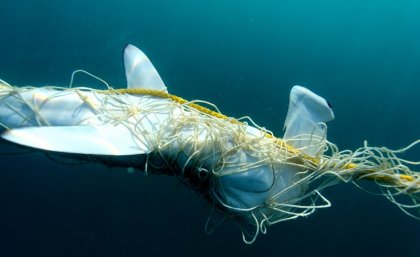
Queensland’s coastal shark numbers are continuing a 50-year decline, in sharp contradiction of suggestions of ‘exploding’ shark populations, according to an analysis of Queensland Shark Control Program data.
University of Queensland and Griffith University researchers analysed data from the program, which has used baited drumlines and nets since 1962 to minimise human-shark interactions, and now spans 1760 km of the Queensland coastline.
UQ School of Biological Sciences researcher Dr George Roff said historical baselines of Queensland shark populations were largely unknown, despite a long history of shark exploitation by recreational and commercial fisheries.
“Explorers in the 19th century once described Australian coastlines as being ‘chock-full of sharks’, yet we don’t have a clear idea of how many sharks there used to be on Queensland beaches,” he said.
“Shark populations around the world have declined substantially in recent decades, with many species being listed as vulnerable and endangered.”
By analysing the Queensland Shark Control Program data, the research team reconstructed historical records of shark catches to explore changes in the number and sizes of sharks over the past half century.
“What we found is that large apex sharks such as hammerheads, tigers and white sharks, have declined by 74 to 92 per cent along Queensland’s coast,” Dr Roff said.
“And the chance of zero catch – catching no sharks at any given beach per year – has increased by as much as seven-fold.
“The average size of sharks has also declined – tiger sharks and hammerhead sharks are getting smaller.”
“We will never know the exact numbers of sharks in our oceans more than half a century ago, but the data points to radical changes in our coastal ecosystems since the 1960s.
“The data acts as a window into the past, revealing what was natural on our beaches, and provides important context for how we manage sharks.
“What may appear to be increases in shark numbers is in reality a fraction of past baselines, and the long-term trend shows ongoing declines.
“While often perceived as a danger to the public, sharks play important ecological roles in coastal ecosystems.
“Large apex sharks are able to prey on larger animals such as turtles, dolphins and dugongs, and their widespread movement patterns along the coastline connects coral reefs, seagrass beds and coastal ecosystems.
“Such losses of apex sharks is likely to have changed the structure of coastal food webs over the past half century.”
The research is published in Communications Biology (DOI: 10.1038/s42003-018-0233-1).
News editors please note - Images of sharks are available via Dropbox.
Media: Dr George Roff, g.roff@uq.edu.au, +61 (0)432 931 051; Dr Christopher Brown, chris.brown@griffith.edu.au, +61 (0)439 835 343; Dominic Jarvis, dominic.jarvis@gmail.com, +61 (0)413 334 924.









